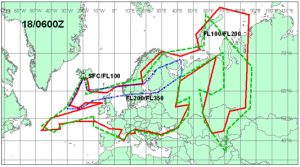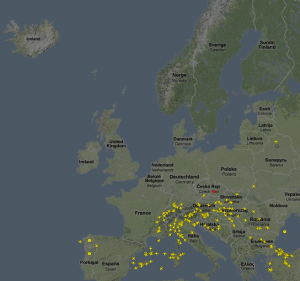Archive for April, 2010
Das ist der Titel der neusten Pressemitteilung eines Forschungsprojekt der TU Dresden und der Universität Potsdam. Man mache sich keine Sorgen um den Verstand der beteiligten Professoren, die Mitteilung wurde von einer Organisation zur Verbreitung der Online-Blindenschrift verfasst, die sich “Ergebnistransfer HyperBraille” nennt. Unter W2lkd10gQmxpbmRlIFBDLU51dHplciBrw7 ZubmVuIGpldHp0IEdyYWZpa2VuI OKAnnNlaGVu4oCc hat man sich ein “HyperBraille-Flächendisplay” vorzustellen, was wohl sowas wie ein computergesteuertes, variables Nippelmuster sein könnte …

HyperBraille Flächendisplay (c) hyperbraille.de
As airlines start bullying airtraffic controllers, eurocontrol becomes defiant on twitter: “For clarification: we do not take decisions as to whether to open/close airspace. Decision made by national authorities in each country” and “We’re responsible for ensuring that all involved, including airlines and ANSPs are then aware of decisions made by national authorities”.
Dutch KLM chiefs Peter Hartman and Ype de Haan believe, “there is no reason to suspect that anything is amiss.” Hear, hear, … so losing the odd plane might be cheaper for them than the virtual loss of 3.4 % in share prices?
Meanwhile, in Switzerland, the ash cloud has been measured and preliminary results are made public (including visualisations of original data). Pilots should now that their on-board radar does not pick up volcanic ash (otherwise they might re-check this instructional video produced by http://www.icao.int/).
PS: reports on a “near miss” of Ural Airlines trying to fly below the ashcloud and having to emergency land due to low fuel on (illegally?) open Vienna airport.
This is the current forecast for the ash cloud for 06:00 UTC on April 18th — the red curve shows the size of the cloud at flight level 100 (FL100, the pressure altitude in units of 100 feet). This means this is essentially a “no-fly-zone” for any height below approximately 3000 meters.

MET office -- ash cloud forecast for 18 April 0600 UTC (from: http://www.metoffice.gov.uk/aviation/vaac/data/VAG_1271508253.png)
And below is an excerpt of the official air space closures “VOLCANIC ASH – UPDATED AT 1600 UTC” collated by Eurocontrol — compare the “closed until” times with the forecast in the map. I am surprised how authorities create a climate of hope with these closure times (e.g. Netherlands: 18th, 0000 UTC) when it is obvious from the forecast, that the closure will be extended by probably another 12 to 24 hours. This is not only angering passengers, but aircraft operators as well.
Airspaces zero-rated/closed until:
(Aerodromes geographically located within these airspaces will be unavailable):EB Belgium 18-0600 UTC
EDGG Langen 18-0600 UTC
EDGG Dusseldorf 18-0600 UTC
EDWW Bremen 18-0000 UTC
EDMM Munich 18-0600 UTC
EE Estonia 18-0000 UTC
EF Finland 18-0000 UTC
EG UK 18-0600 UTC
EH Netherlands 18-0000 UTC
EI Ireland 18-1200 UTC
EK Danmark 18-0600 UTC
EN BODO South 18-0000 UTC
EN OS 17-2200 UTC
EN SV 17-2200 UTC
EP Poland 17-1800 UTC
ES Sweden 18-0600 UTC
LD Croatia 18-0000 UTC
LE Pamplona 18-0000 UTC
LFBB France 17-2359 UTC
LFEE France 19-0800 UTC
LFFF France 19-0800 UTC
LFMM France 17-1800 UTC
LFRR France 17-1800 UTC
LH Hungary 17-1800 UTC
LIMM Milan 18-1200 UTC
LIPP Padova 18-1200 UTC
LIRQ + LIPY + LIRP 18-1200 UTC
LJ Slovenia 18-0000 UTC
LK Chech Republic 18-0000 UTC
LO Austria East 17-2100 UTC
LO Austria all main A/D 18-0000 UTC
LR Romania 17-2100 UTC
LS Swiss 17-1800 UTC
LYBA Serbia 18-0000 UTC
LZ Bratislava 18-0000 UTC
UK Ukraine 17-1500 UTC
UKVB 17-1800 UTC
UKDV ACC 17-1800 UTC
UKLV ACC 17-1800 UTCPlease note, these lists are not exhaustive.
Es ist ein drittes Max-Frisch-Tagebuch veröffentlicht worden. Konnte man ja schon vor längerer Zeit im Sumpf des deutschen Feuilletons lesen. Heute erst wird bekannt, welche Mühen Herausgeber und das Max-Frisch-Archiv auf sich genommen haben müssen: “Das Tagebuch wurde 2009 in einem nicht zugänglichen Teil des Max Frisch-Archivs an der ETH Zürich entdeckt.” Vermutlich haben sie kurzerhand den nicht zugänglichen Teil des Archivs mit dem Large Hadron Collider des CERN als Parallelwelt simuliert. Oder so ähnlich.




